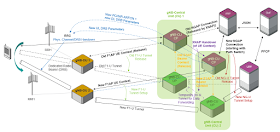In previous blog posts I have discussed intra-gNB-DU handover and inter-gNB-DU handover scenarios.Now it is time to look at inter-gNB-CU handover that uses the Xn interface.
At the RRC protocol layer there will be the measurement setups and measurement reports as in the intra-gNB handover cases. And F1AP UE Context Setup and Release Procedures are identical with the ones discussed for inter-gNB-DU handover. Only the cause values are expected to be different, e.g. "successful handover".
Thus, I do not want to focus here on la adder diagram call flow (that is by the way very well described in 3GPP 38.401, chapter 8.9.4), but invite you to have a look at a "big picture" that you see below.
What characterizes the inter-gNB handover is the transfer of the UE RRC/NGAP context form the source gNB-CU to the target gNB-CU. When the Xn interface is available to connect two neighbor gNBs this context transfer is executed using the XnAP Handover Preparation procedure. The Initiating Message of this procedure transfers the UE context parameters to the target gNB-CU. Then embedded in the Successful Outcome message the handover command is sent in return to the source gNB-CU that forwards it to the UE. In addition a temporary user plane transport tunnel for the purpose of data forwarding is established and later on released on the Xn user plane interface.
Once the UE performed the handover on the radio interface all the transport tunnels for the payload transmission need to be switched from the old gNB to the new one. This includes the tunnel to the UPF that is managed by the NGAP. Thus, the target gNB-CU starts the NGAP Path Switch procedure.
In the target gNB environment it is necessary to establish a new F1AP UE context, new E1AP Bearer Context and new F1-U payload transport tunnel. All this happens BEFORE the Handover Command is sent to the source gNB/UE. And once there is an indication that the handover is completed all the radio and transport resources controlled by the source gNB will be released.
So the figure above looks complicated, but actually the underlying logic of context/data forwarding, radio resource allocation and transport tunnel switching is quite simple.
Special note: In case there is no Xn interface available the UE context/handover information can be transmitted using NGAP Handover Preparation procedure on the source side of the connection and NGAP Handover Resource Allocation procedure on the target side of the connection.
Related Posts:
At the RRC protocol layer there will be the measurement setups and measurement reports as in the intra-gNB handover cases. And F1AP UE Context Setup and Release Procedures are identical with the ones discussed for inter-gNB-DU handover. Only the cause values are expected to be different, e.g. "successful handover".
Thus, I do not want to focus here on la adder diagram call flow (that is by the way very well described in 3GPP 38.401, chapter 8.9.4), but invite you to have a look at a "big picture" that you see below.
(click image to enlarge)
What characterizes the inter-gNB handover is the transfer of the UE RRC/NGAP context form the source gNB-CU to the target gNB-CU. When the Xn interface is available to connect two neighbor gNBs this context transfer is executed using the XnAP Handover Preparation procedure. The Initiating Message of this procedure transfers the UE context parameters to the target gNB-CU. Then embedded in the Successful Outcome message the handover command is sent in return to the source gNB-CU that forwards it to the UE. In addition a temporary user plane transport tunnel for the purpose of data forwarding is established and later on released on the Xn user plane interface.
Once the UE performed the handover on the radio interface all the transport tunnels for the payload transmission need to be switched from the old gNB to the new one. This includes the tunnel to the UPF that is managed by the NGAP. Thus, the target gNB-CU starts the NGAP Path Switch procedure.
In the target gNB environment it is necessary to establish a new F1AP UE context, new E1AP Bearer Context and new F1-U payload transport tunnel. All this happens BEFORE the Handover Command is sent to the source gNB/UE. And once there is an indication that the handover is completed all the radio and transport resources controlled by the source gNB will be released.
So the figure above looks complicated, but actually the underlying logic of context/data forwarding, radio resource allocation and transport tunnel switching is quite simple.
Special note: In case there is no Xn interface available the UE context/handover information can be transmitted using NGAP Handover Preparation procedure on the source side of the connection and NGAP Handover Resource Allocation procedure on the target side of the connection.
Related Posts:








